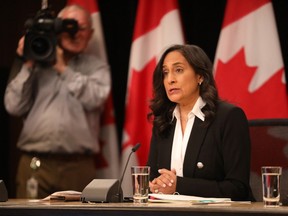The federal government is undertaking a multi-billion dollar spending review to ‘refocus’ parts of its budget

The federal government is currently looking for ways to tighten its budget and curb the size of the public service. In order to do that, it’s undertaking a multi-billion dollar spending review.
Here’s what you need to know about the review and how it could impact federal employees.
What is the spending review?
In Budget 2024, the federal government announced a second phase of the spending review process that would seek to achieve savings “primarily through natural attrition in the federal public service.” The budget said that beginning on April 1, 2025, federal departments and agencies would be required to cover “a portion of increased operating costs” through their existing resources.
As part of the spending review, Anand tasked departments and agencies with developing savings proposals to hit budget reduction targets the government refused to release, claiming they were protected under cabinet privilege. The Treasury Board has also refused to release the plans each department and agency has come up with to meet those targets, saying they are a “cabinet confidence” as well.
It’s likely the federal government won’t release the targets and savings proposals until March 2025 when it will table spending estimates in the House of Commons.
How will public servants’ jobs be impacted?
It’s unclear at this point if any permanent employees will be laid off. The Treasury Board has maintained that it expects that “any job reductions resulting from these savings would be realized through natural attrition to the greatest extent possible.”
But it hasn’t closed the door to layoffs. And internal emails, obtained by the Ottawa Citizen, show that some departments and agencies have already decided where they’re making cuts.
An email signed by the CRA Commissioner Bob Hamilton and Deputy Commissioner Jean-François Fortin said the agency was implementing several hiring restrictions as of Nov. 7. It said that permanent promotions of CRA employees, new student appointments and new term appointments for non-critical workloads would no longer be allowed. It said the CRA would stop promoting temporary employees to be permanent, and wouldn’t hire students or new temporary workers for “non-critical workloads.”
The email also said the CRA would consider reducing the use of consultants and ending acting assignments early.
An internal message from Immigration, Refugees and Citizenship Canada said the department would be “stopping the clock” on “term rollovers” as of Oct. 31, 2024, meaning that temporary workers on contracts will no longer automatically become permanent employees after three years of service.
Innovation, Science and Economic Development has also confirmed to the Ottawa Citizen that it has limited external hires and has implemented a “stop the clock” provision for temporary employees, a decision that will impact 356 workers in the department.
Are any organizations exempt from the spending review?
The spending review process doesn’t apply to every department and agency.
According to Martin Potvin, a spokesperson for the Treasury Board, there are some government organizations that are exempt from the spending review, including those with annual operating budgets of less than $25 million; agents of Parliament; Crown corporations and organizations “exempted in the public interest.”
While Potvin said a final list of exempted organizations would not be available until the government tables spending estimates in the House of Commons in March 2025, several organizations have confirmed to the Ottawa Citizen that they are not part of the process. They include the Office of the Privacy Commissioner of Canada, the Office of the Information Commissioner, the Public Prosecution Service of Canada and the Office of the Commissioner of Official Languages.
Elections Canada said it was also exempt “given the current minority government context in which a general election can be called at any time.”